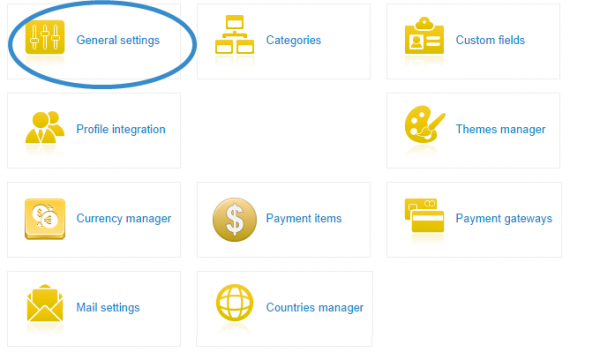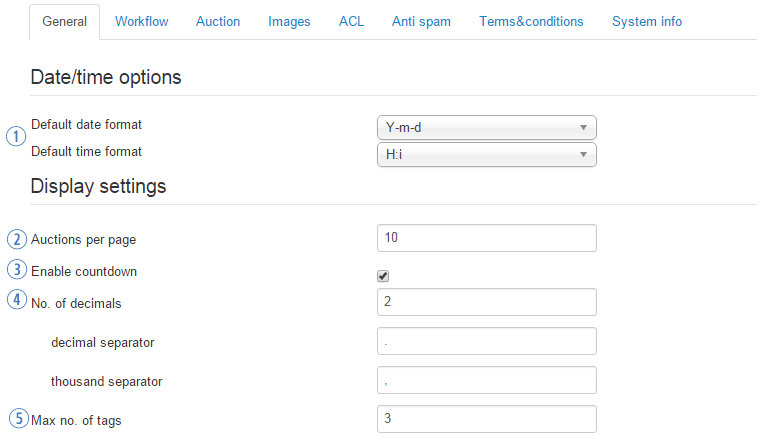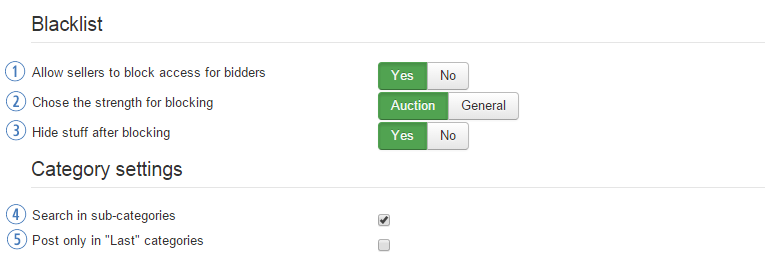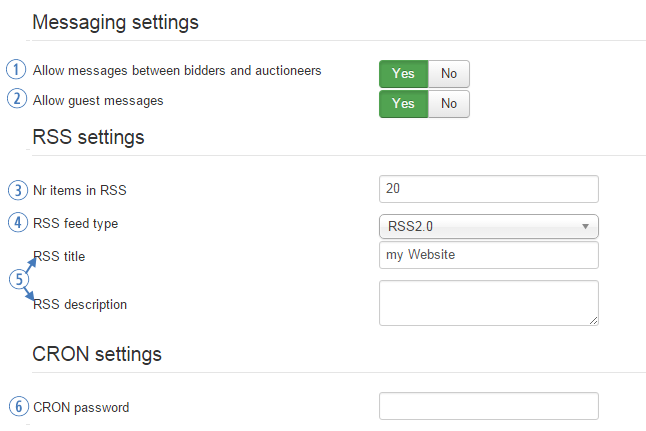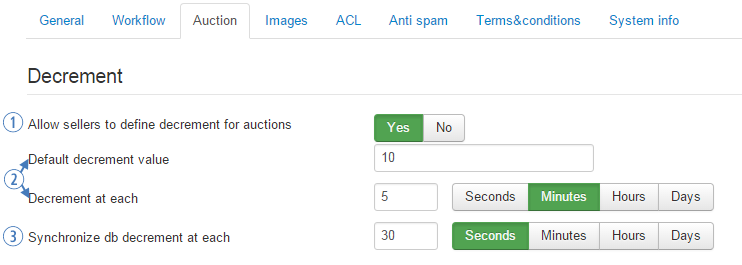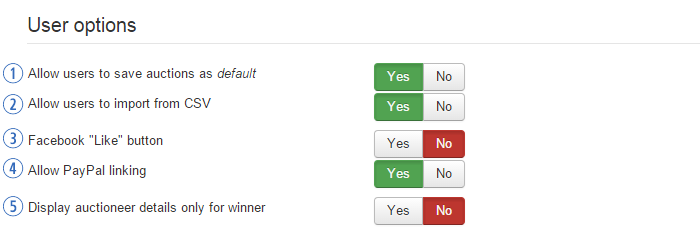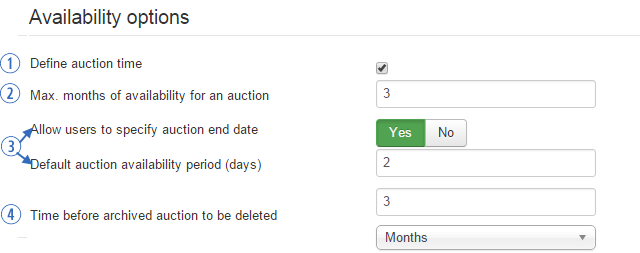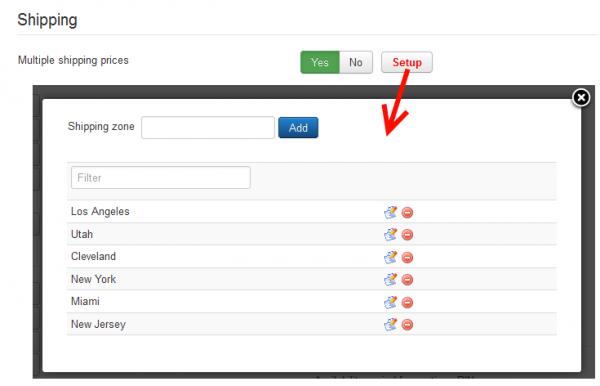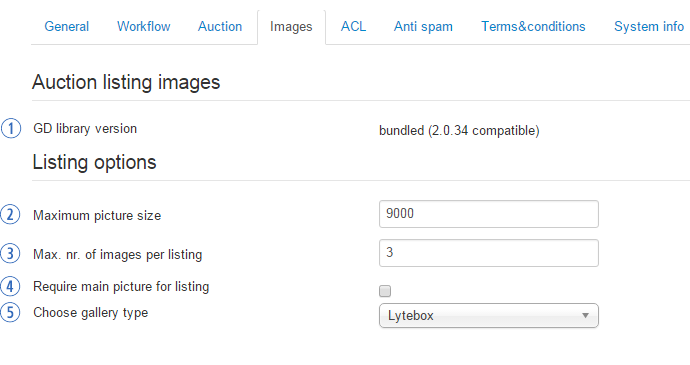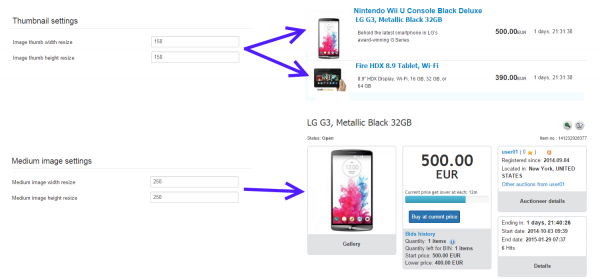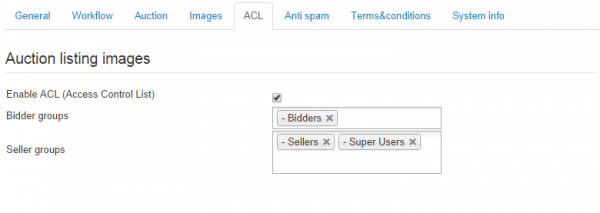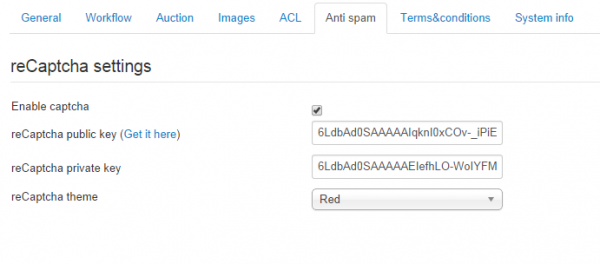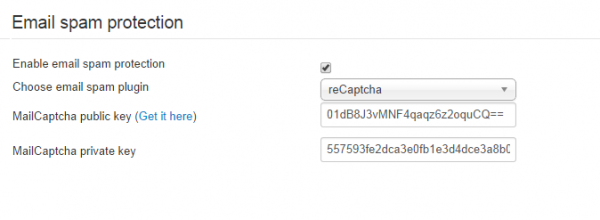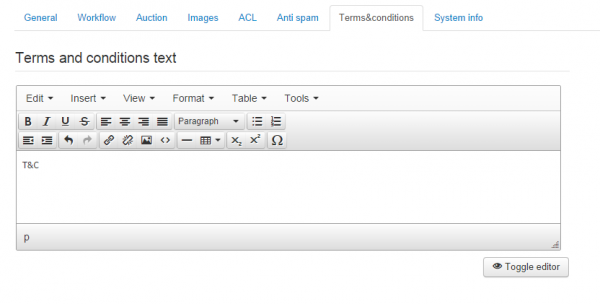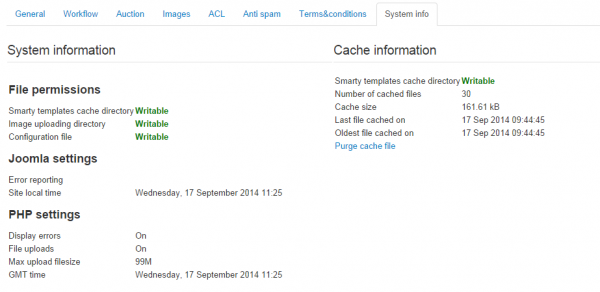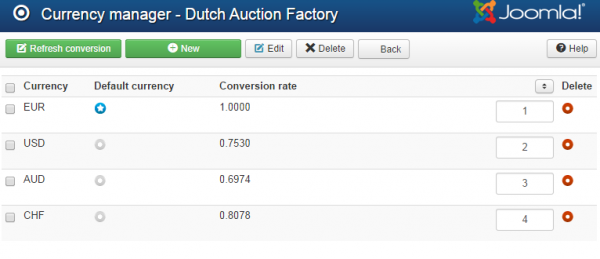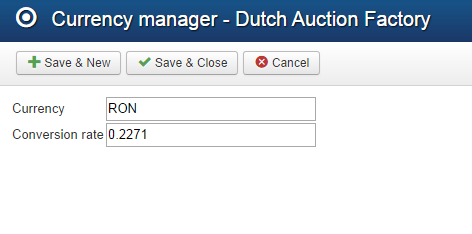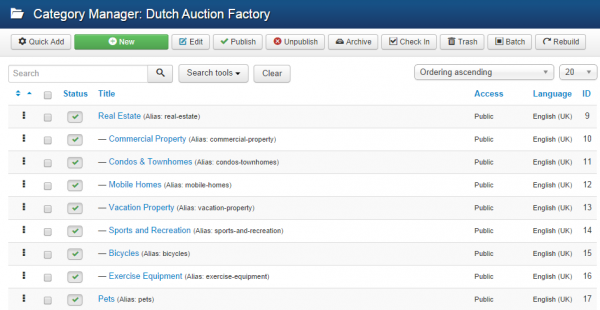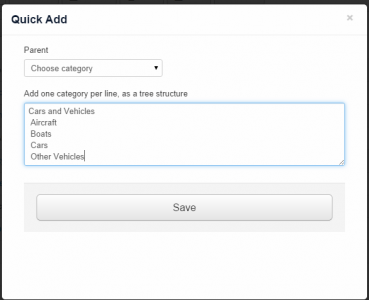Table of Contents
Configuration
To access most of the Dutch Auction Factory backend options go to Dutch Auction Factory's Control Panel and click on General Settings.
General Settings
Display Settings
1. Choose the desired Date and Time format for auctions. "d" stand for Day, "m" for Month and "Y" for Year. “H:i” is for a 24-hour representation of time while “h:iA” is for a 12 hour.
2. Auctions per page will set how many auctions will be displayed on listings. If the respective number is exceeded, pagination will be created. This is just a default value, every user will be able to set on his own the number of auctions displayed on his listings.
3. Enable countdown adds a timer for each auction shown on the listings, which represents the amount of time left until that auction closes.
4. Define how the prices will be displayed by setting up the Number of decimals and the separators for decimals and thousands. As separators, it is preferred to use a period "." or a comma ",".
5. Set the Max Number of Tags allowed per auction. Tags are an excellent way for auctions to be filtered in a search. However, if a user puts too many tags, his auction will pop up in every search. Some people may find this annoying. To ensure this does not happen, you should post a limited number of tags, and choose only the tags that are suited for your auction.
Blacklist and Category Settings
1. Allow sellers to block access for bidders option, if enabled, gives sellers the ability to add on their personal Blacklist various bidders. These bidders won't be able to access the respective sellers auctions, send them messages or any adding actions.
2. Choose the strength for blocking option allows you to select how the blocking process works, either per auction or general blocking.
3. Since blocking a user will make him unable to bid or send messages to the respective seller, you can also enable Hide stuff after blocking, which hides all messages and bids.
4. You can also allow searches to be made in the sub-categories of the selected category, with the Search in sub-categories option.
5. Restrict users from posting auctions in categories which have sub-categories, by enabling Post only in "Last" categories.
Messaging, RSS and CRON Settings
1. Our component offers a messaging system, which gives bidders the possibility to interact with the auctioneers and vice versa.
2. You can also enable Allow guest messages, which will give guests the possibility to write messages on auctions. However, it is highly recommended that you enable and set up ReCaptcha for this, in order to avoid any unwanted bot spam.
RSS Feed is also available with our component. You can set it up from the RSS settings area.
3. Define Number of items in RSS to set how many auctions to be displayed on the feed.
4. Select the RSS feed type you wish to be used (RSS2.0, RSS1.0, OPML, ATOM, etc).
5. Add a Title and a Description of your feed.
6. Set a CRON Password which will be used to safely call the CRON script. For more information regarding this topic, please visit our CRON documentation.
Workflow
From the Workflow tab you can set up a couple of things regarding certain processes of the component related to the auction workflow.
1. You can choose from 2 different ways of which the users can post their auctions:
- a one-step posting, where the auction information is entered on one page.
- two-steps posting, which will require users to set the category first and the rest of the details afterward.
2. Besides ACL, the auctions can also be actively moderated. With the use of the Admin must approve every listing option, all auctions will need to be manually approved by an admin on the backend before publishing them.
Auction Settings
Decrement
1.In Dutch Factory, the prices of the items can be lowered in time using a decrement. From here you can set default values of the said decrement or to Allow sellers to define decrement for auctions, by enabling the option.
2. If the option presented above is disabled, you will need to set a Default decrement value and the period of its occurrence in seconds, minutes, hours or days.
In case you enabled the option, the set values will still be displayed on the fields, but the users will be able to change them accordingly.
3. Synchronize db decrement at each: Use this option in order to add a synchronize value in seconds, minutes, hours or days. This will indicate the amount of time between the synchronizations of the database, regarding the decrement. The frontend display of the decrement will not be affected by this setting since it is based on Javascript.
Pay attention to not use an interval which is too short, in order not to overload the server and not too long either.
User Options
1. Allow users to save auctions as default will enable a feature that will record values from certain fields when creating an auction. Those fields will be auto-filled on the respective user's future auctions. A special tab will also be available on his profile, where he can edit these values. To change those default values, the seller can also check a box in the auction form.
2. Enabling Allow users to import from CSV will add a button on the My auctions page, which users can click on to bulk import auctions. The users will do so by uploading a CSV file with the proper structure and an image archive that corresponds to the uploaded CSV. Proper structure has to be followed in the CSV in order for the import to work properly.
3. Having a Facebook integration within our component allows you to add a "Like" button on all auction detail pages and user profile pages by enabling the Facebook "Like" button option found in this section.
4. Allow PayPal linking will give the auction winner the possibility to use sellers' PayPal address to pay. When the seller has the PayPal field completed in his profile, a button will show, for the winner, on the auction with the winning bid. This button will redirect the bidder to PayPal for payment with the value of the bid towards the seller.
5. With Display auctioneer details only for winner you can either display the contact details of sellers to all the users or hide them and make them available only for the winner bidders and only the auctioneer. This is available for privacy purposes.
Availability options
1. While users can set a starting and ending date for their auctions, having Define auction time enabled will also allow them to set a precise time, in which the auctions will start and end.
2. Set the maximum period of time accepted for new auctions on Max. months of availability for an auction. Sellers will not be able to post auctions for longer than this period if time and will be informed promptly to set a lower availability period.
3. With Allow users to specify auction end date enabled, you give users the possibility to set the exact date when their auctions will end. Otherwise, a default availability value will be used. Under this option, you can set the default value (in days) for the auctions.
4. Set after how much time archived auctions will be deleted. An auction is considered archived after it is closed. You can also purge all closed auctions from the Tools page.
Shipping prices
When creating new auctions, users can add details regarding their shipment. By enabling Multiple shipping prices and saving the change, a Setup button will appear, which allows you to add an unlimited amount of cities/regions/countries as shipping zones.
The shipping zones added on backend will be visible for sellers when creating new auctions, They will be able to add these zones and specific prices for each of them.
Images
1. Check your current version of the graphic library on the Auction Listing Images area.
2. Set a Maximum picture size. If a picture of a bigger size is being uploaded, the upload will cancer and the user will be notified about the maximum allowed size.
3. To prevent any over-flood on your website you can limit the Max. nr. of images per listing.
4. Require main picture for listing will make the main picture required for all new listings. This is useful since auctions that have at least one picture, statistically, have more viewers, thus more chances of getting a higher price.
5. There are 3 Gallery Types you can choose from that have different behavior: Scroll Gallery, Lytebox and Picture Slider. Be sure to check them out one by one to see which one of them suits your website better.
There are two image sizes that can be set by you on this page. These are not for the full-sized versions, but for their thumbnails, which are shown on the listings and auction details pages.
Thumbnail settings allows you to change the width and height of the images, found on the listing pages such as My auctions and List auctions. Medium image settings is assigned to the images found in the detailed view of auctions.
(!) The full-size modal box, which appears when clicking on the image, is resized dynamically in Javascript according to the clients' resolution.
That means that for any resolution the browser has, the image is always centered and about 90% of the height or width are available on screen.
Access Control List
Enabling the ACL function of the component will allow you to select which specific groups of users are allowed to post auctions or place bids.
It is recommended that you create 2 new groups for both the sellers and the bidders and set proper access levels before setting this up.
For more information regarding the ACL please visit our Dutch Auction Factory - Access Control List Guide.
Anti-Spam
To protect your website against unwanted spam you can use reCaptcha and email protection features such as reCaptcha Mailhide.
The reCaptcha form will pop up when guests attempt to post comments on auctions.
Check the Enable Captcha checkbox and then press on the Get it here link, which will redirect you to ReCaptcha's website. Follow the instructions found there and copy/paste the public and private keys.
Optionally, you can change the reCaptcha theme to either Red, White, Backglass or Clean.
From the Email Spam Protection area you can enable one of the available email protection features, by checking the checkbox and selecting which type you wish to be used.
The reCaptcha Mailhide works the same way as a regular reCaptcha, but it is used when users want to see email addresses. Other mail protection methods are Smarty and Joomla. Smarty obfuscates the source code with Javascript, while Joomla simply hides the email.
In case you choose reCaptcha Mailhide, you have to add a public and a private key. Clicking on Get it here will take you to the ReCaptcha's website to obtain the public and private keys.
Terms & Conditions
This tab comes with a simple WYSIWYG editor where you can add your websites' Terms and Conditions.
Users will have to read and agree to the Terms and Conditions added by you in this editor in order to create new auctions or place bids.
System Info
The System Info tab is implemented to provide basic information about the cache directory, upload directory or configuration file. These are useful for debugging if any issues arise. The component handles the configuration file permissions itself. Even if the configuration file might be Unwritable, the component will still be able to save the configuration and restore previous permissions.
(!) After working on the smarty .tpl files, it is recommended to purge the cache so the changes can take effect right away. Remember that browser caching can also affect how changes are updated.
Currency Manager
Currency Manager page, which is accessible from the Control Panel seen above, allows you to manage the list of currencies used on your website.
You can select a default currency, so that, when payments are made with other currencies, it will convert them automatically and recalculate the commission.
These payments also include the payment items offered by our extension which can be seen here.
In case a payment item is disabled, it will not update to a new default currency, so be sure the payment items which you wish to use are enabled before switching to another currency.
Clicking on Refresh Conversion will update the rates using Yahoo conversion. When changing the default currency, the currencies and prices for payment items will also be updated.
Clicking on New will let you add new currencies. Simply add the currency abbreviation and, optionally, the conversion rate. In case you don't know the conversion rate of the respective currency, you can leave the field empty and click on the Refresh Conversion button afterward to update it. The CRON script also updates currency exchange rates according to Yahoo. Check the CRON documentation for more.
It is recommended that you use the valid ISO currency codes in order for the conversion to work properly.
Categories
Each auction can be assigned to a specific category, which represents the type of item which will be sold. These are not Joomla categories that can be seen on Content/Category Manager.
To define Dutch Auction Factory categories you need to go to the Settings part of the component, and then on the Category Manager page, which will allow you to add new categories, edit, or sort the order of the already existing ones.
The component supports unlimited category levels and unlimited sub-categories. You can create a sub-category by setting a Parent.
With version 4.0.0 of the component you can also use a Quick Add feature, which allows you to add multiple categories in one run. To use this, you will need to make sure the Dutch Auction Factory System plugin is enabled. You can verify this by going to "Extensions/Plugin Manager".
Once the plugin is enabled, clicking on the Quick Add button will open a modal window where you can choose a parent category and write multiple categories on the text field. Be sure to add them one per line.In order to add a subcategory, just leave a space before entering your text. Leaving the parent as "Choose Category" will create main categories.
(!) Documentation based on Dutch Auction Factory version 2.0.1.


